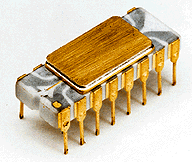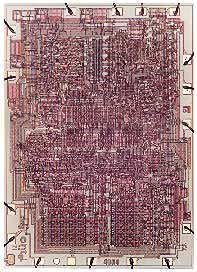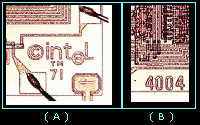| |
The Intel®¹ 4004 Microprocessor
Although its first use was to be inside a calculator, the engineers who designed
this "chip" intended for it to be the heart of the first "general
purpose" micro-computer!
The 4004 was introduced as the world's first microprocessor
on the 15th of November, 1971.
_____________
¹ The company name, INTEL®, is an
abbreviation for "Integrated
Electronics" (not for the word
intelligence as some have assumed).
|
I found the picture below at a
site spoofing Intel®, so it may not be reliable.
Does anyone know for sure if this is a 4004? ( It was displayed as a mirror
image of the pic below; pin 1 is now shown correctly here! )
Is it really "intel® inside"?

A 16-pin DIP (
dual-in-line package).
|
An Amazing Bit of History
The 4004 provided the computing power for
Pioneer 10. The spacecraft was launched on March 2, 1972 and later
obtained the first close-up images of Jupiter, charted Jupiter's radiation
belts, located the planet's magnetic field, and finally established that
Jupiter was indeed predominantly a liquid planet.
NASA scientists communicated with Pioneer 10 long after the Jupiter
mission: Their last set of instructions were sent on November 30, 1997 and
took roughly nine hours to reach the craft. The signal strength was too weak
to receive any data from the instruments after that, but it was still quite
healthy. All contact was lost in 1998 when Pioneer passed beyond the range
at which even the most sensitive antennas could detect it's signal. [ In February, 2000, Pioneer 10 was approximately 11.07
billion kilometers ( 6.879 billion miles ) from the earth and speeding away
from the sun at 12.24 km/sec ( 27,380 mph ). Radio signals (or light ) take
about 10 hours 15 minutes to travel this distance. ( See the link below for
more info on the Pioneer spacecraft.) ]
Photograph of the 4004
"chip"

|
The "Chip" is
really inside the DIP
This photograph shows the actual 4004 "chip" itself which was only
an eigth-inch wide by a
sixth-inch long (0.125" x 0.167").
Wires were welded to the 16 small square pads around the edge of the chip, and then
to the pins on the outside of the DIP to make connections with other parts on a
circuit board.
| Two detailed views: (A) showing the
Intel® logo and 71 (for 1971) at the lower-left corner, and (B)
the 4004 from the bottom edge. |
 |
Click here for a 506 x 676 view of the 4004 chip (410 Kb).
|
Some Facts About the 4004 Microprocessor ²
- Comprised of 2,300 transistors (10-micron technology).
- Set of 50 instructions, (8-bit instructions are processed 4-bits at a time).
It appears that the 4004 originally
had only 46 instructions.
- Roughly 60,000 instructions per second (
But, see Instruction Speed below).
- 4-bit data/address bus.
- 4-bit accumulator with separate carry and
test bits,
- Sixteen(16) 4-bit 'scratch-pad' registers
(which can be used as eight 8-bit registers),
- A 12-bit PC ( program counter ), and
- three more 12-bit registers comprising an address stack.
Instead of creating a separate data and address bus between the 4004 and its
support chips, successive 4-bit bytes of its 12-bit addresses were
"multiplexed" over the 4-bit data bus. Multiplexing gives the 4004 a
smaller size, but at the price of a slower speed:
It must first use three(3) whole clock cycles just to load an instruction's address into
the CPU, two(2) clock cycles for the CPU to fetch the instruction, and another three(3)
cycles to actually execute the instruction for a total of eight(8) cycles per instruction.
( Note: There are eleven(11) 8-bit instructions which take
twice as long: That is, they require sixteen(16) clock cycles to complete!)
Instruction SpeedThe 4004 can operate with
clock periods between 1.35 and 2.00 microseconds, or 500.00 KHz to
approx. 740.74 KHz ( rate in Hertz = 1 divided by the time period).
Using a maximum clock rate of 740 KHz, the 4004 could execute 1-byte instructions
at 92,500 per second, and 2-byte (8-bits) instructions at half that, or 46,250 per
second. The simple average of the two would give 69,375 per second, although I
have seen 60,000 per second given most often -- so, it all depends on exactly
how many 4-bit and 8-bit instructions are being run.
_________________
² From a comparison of various Internet sources, and
data found in the book, Microcomputer-Based Design, John B.
Peatman (©1977 by McGraw-Hill, Inc.).
Origins of the 4004 Microprocessor
" In 1969, Busicom, a Japanese calculator manufacturer, asked Intel
to design a set of chips for a line of high-performance programmable
calculators. Busicom's original design required several chips, which Intel
engineer Marcian E. (Ted) Hoff considered too complex to be cost effective.
Also, Intel's small MOS staff was fully occupied with the 1101 memory chip,
so design resources weren't available. Instead of the multi-chip solution,
Hoff came up with a general-purpose processor that could be programmed for
various uses. At first, Busicom was sceptical about the design, but in early
1970 they agreed to the concept and signed a contract whereby Intel would
develop the calculator chips for $60,000. Intel delivered the chips, and
Busicom eventually sold some 100,000 calculators. Once Intel realised the
potential of the new chips, the company offered Busicom a lower price in
return for the rights to the microprocessor design and the rights to market
it for non-calculator applications. Busicom, by then in financial trouble,
agreed to the deal. "
— For further reference see Intel's website:
The History of Intel, 30 Years of Innovation.
 Return to The Starman's Home Page
Return to The Starman's Home Page
 The Pioneer (10 &11) Projects Home Page.
The Pioneer (10 &11) Projects Home Page.
Since August 1, 1998.



